Axicons, Zinc Selenide
- ZnSe Ideal for IR Applications
- AR Coated for 7 - 12 µm
- 1" Diameter
- Apex Rounding Diameter: <1.0 mm
AX7252-E3
2.0° Physical Angle
AX72505-E3
0.5° Physical Angle
AX72501-E3
0.1° Physical Angle
Axicon Ray Tracing Diagram

Please Wait
| Common Specifications | |
|---|---|
| Substrate Material | Zinc Selenidea |
| AR Coating Range | 7 - 12 µm |
| Reflectance (per Surface)b |
Ravg < 1%; Rabs < 2% |
| Transmissionb | Tavg > 97%; Tabs > 92% |
| AR Coating Plotc | |
| Diameter | 1" (25.4 mm) |
| Diameter Tolerance | +0.0 / -0.05 mm |
| Apex Rounding Diameter (S1) | <1.0 mm |
| Surface Quality (S1, S2) | 60-40 Scratch-Dig |
| Surface Flatness (S2) | <λ/2 at 633 nm |
| Surface Deviation (RMS) (S1) | <0.07 µm |
| Surface Roughness (RMS) (S1,S2) | <20 Å |
| Clear Aperture (S1, S2) | >Ø22.86 mm |
| Edge Thickness | 3.4 mm |
| Center Thickness Tolerance | ±0.1 mm |
| Angular Tolerance | ±0.01° |
| Axicons Selection Guide | |
|---|---|
| UV Fused Silica Axicons | Unmounted |
| Mounted | |
| ZnSe Axicons | Unmounted |
| Click on the red Document icon next to the item numbers below to access the Zemax file download. Our entire Zemax Catalog is also available. |
Click to Enlarge
Figure 1.1 This diagram shows the definitions of thicknesses and angles used on this page.
Features
- Transform a Collimated Beam into a Ring
- Five Physical Angles Available: 0.1°, 0.2°, 0.5°, 1.0°, and 2.0°
- Broadband AR Coating with Ravg <1% from 7 to 12 µm
An axicon, also known as a rotationally symmetric prism, is a lens that features one conical surface and one plano surface. They are commonly used to create a beam with a Bessel intensity profile or a conical, non-diverging beam. When converting a collimated beam into a ring, the plano side of the axicon should face the collimated source.
These axicons are offered with base angles from 0.1° to 2.0° and are precisely manufactured from zinc selenide (ZnSe), making them ideally suited for mid-infrared laser applications and for use with CO2 laser applications, like materials processing. ZnSe axicons are offered with our -E3 antireflection coating for 7 to 12 µm. The coating is deposited on both sides of each optic in order to improve transmission by reducing surface reflections. Additionally, ZnSe axicons provide enough transmission in the visible region of the spectrum to allow the use of a red alignment beam, such as a HeNe laser.
An axicon deflects light according to Snell's Law, which can be used to find the deflection angle:
where n is the index of refraction of the glass, α is the physical angle of the prism, and ß is the angle the deflected beam creates with the optical axis. Here, the refractive index of air is assumed to be 1. This interaction is illustrated in Figure 1.1.
When handling optics, one should always wear gloves. This is especially true when working with zinc selenide, as it is a hazardous material. For your safety, please follow all proper precautions, including wearing gloves when handling these lenses and thoroughly washing your hands afterward. Due to the low hardness of ZnSe, additional care should be taken to not damage these lenses. Click here to download a PDF of the MSDS for ZnSe.
Thorlabs also offers Ø1/2" and Ø1" UV Fused Silica Axicons, either uncoated or with an AR coating, and with physical angles ranging from 0.5° to 40.0°.
 |
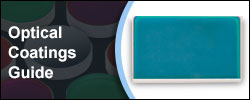 |
Axicon Beams
- Bessel Beam: Non-Diffracting
- Ring-Shaped Beam: Ideal for Laser Drilling
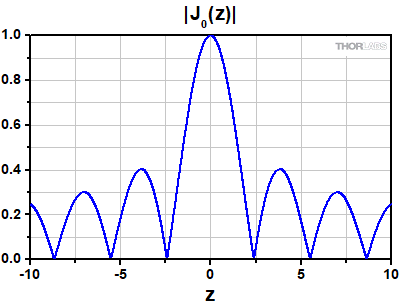
Figure 2.2 The absolute value of a 0th order Bessel function. A true Bessel Beam requires each ring to have the same energy as the central peak, thus an infinite amount of energy is needed.
A Bessel beam is a non-diffracting beam of concentric rings, each having the same power as the central ring. Technically, a Bessel beam cannot be created as it requires infinite energy. A beam closely resembling a Bessel distribution can be generated by passing a Gaussian beam through an axicon and taking the projection of the beam close to the axicon’s conical surface. The absolute value of a 0th order Bessel function of the first kind is shown in Figure 2.2.
When the beam is projected further from the lens, a single ring-shaped beam is formed. The beam is actually conical (i.e., diameter increases with distance), but the rays are non-diverging so that the thickness of the ring remains constant (see Figure 2.1). The ring's thickness will be half of the input laser beam's diameter. This type of beam is commonly used in laser-drilling applications.
Figure 2.1 Axicon ray tracing diagram.
| Posted Comments: | |
Kenneth Robinson
(posted 2021-05-05 09:01:49.227) I want to generate a bessel beam for a Mid IR laser operating around 2940 nm,m what are the transmission properties of he AR coating in that wavelength range? And do you offer uncoated ZnSe axicons? YLohia
(posted 2021-05-05 02:26:03.0) Hello, the AR coating on these is not suited for the 2940 nm range. Uncoated or different AR-coated axicons (for example the -E4 AR coating for your wavelength range) can be requested by clicking on the "Request Quote" button above or by contacting your local Thorlabs Tech Support team (in your case, techsupport.uk@thorlabs.com). Volker Franke
(posted 2020-12-08 14:24:16.1) ich habe eine optische Frage an Sie. Ich erstelle gerade Pläne für ein Angebot an einen Industriekunden in dessen Auftrag wir im Erfolgsfall Untersuchungen mit einem ringförmigen Laserstrahl machen wollen. Hierzu benötige ich aber zunächst eine Ein-/Abschätzung zur Machbarkeit.
Wir wollen mit einem CO2-Laserstrahl einen relativ großen ringförmigen Fokus generieren. Hier die Eckpunkte zur Orientierung:
- Ringdurchmesser Ziel ca. 40 mm
- Rindbreite (Linienbreite) sollte möglichst klein sein (was geht?) (Wunsch wäre kleiner als 0,4 mm, besser 0,2 mm)
- Arbeitsabstand zwischen Optik und Material sollte groß genug sein um die Optik vor Dreck zu schützen (gefühlt mindestens 100 mm)
- Rohstrahldurchmesser ca. 16-18 mm
- Geschätzte Laserstrahlleistung ca. 600 – 1500 W (das hängt sehr von der realisierten Ringbreite ab)
Wie genau die Optik aufgebaut ist, spielt im Moment noch keine Rolle. Ich vermute man wird mindestens ein Axicon und eine Linse benötigen. Ob die Optiken transmittiv oder reflektiv sind, ist auch erst mal egal. Für erste Tests zur Machbarkeit wollen wir den Aufwand nicht zu groß werden lassen und könnten ggf. ein paar Abstriche von oben genannten Zielwerten machen, wenn dies mit Standardoptiken umsetzbar ist.
Gern würde ich mich mit Ihnen austauschen, was machbar ist, damit ich unsere Arbeitspläne und das Angebot weiter ausarbeiten kann.
Grundsätzlich denken wir als zweiten Lösungsweg auch darüber nach, das Ganze auch mit einem Faserlaser zu testen. Aufgrund der Absorption im Material wäre der CO2-Laser aber bevorzugt.
Über Ihre Rückmeldung und technische Beratung würde ich mich sehr freuen.
Mit freundlichen Grüßen
Volker Franke YLohia
(posted 2020-12-08 11:20:43.0) Hello, thank you for contacting Thorlabs. An applications engineer from our team in Germany (europe@thorlabs.com) will reach out to you directly to discuss this furter. |
Selection Guide for Prisms
Thorlabs offers a wide variety of prisms, which can be used to reflect, invert, rotate, disperse, steer, and collimate light. For prisms and substrates not listed below, please contact Tech Support.
Beam Steering Prisms
| Prism | Material | Deviation | Invert | Reverse or Rotate | Illustration | Applications |
|---|---|---|---|---|---|---|
| Right Angle Prisms | N-BK7, UV Fused Silica, Calcium Fluoride, or Zinc Selenide | 90° | 90° | No | 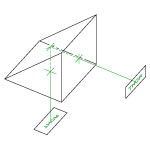 |
90° reflector used in optical systems such as telescopes and periscopes. |
| 180° | 180° | No | 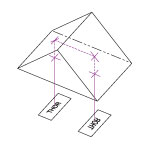 |
180° reflector, independent of entrance beam angle. Acts as a non-reversing mirror and can be used in binocular configurations. |
||
| TIR Retroreflectors (Unmounted and Mounted) and Specular Retroreflectors (Unmounted and Mounted) |
N-BK7 | 180° | 180° | No | 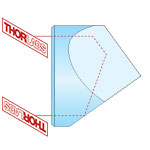 |
180° reflector, independent of entrance beam angle. Beam alignment and beam delivery. Substitute for mirror in applications where orientation is difficult to control. |
| Unmounted Penta Prisms and Mounted Penta Prisms |
N-BK7 | 90° | No | No | 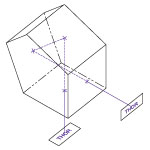 |
90° reflector, without inversion or reversal of the beam profile. Can be used for alignment and optical tooling. |
| Roof Prisms | N-BK7 | 90° | 90° | 180o Rotation | 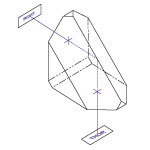 |
90° reflector, inverted and rotated (deflected left to right and top to bottom). Can be used for alignment and optical tooling. |
| Unmounted Dove Prisms and Mounted Dove Prisms |
N-BK7 | No | 180° | 2x Prism Rotation | 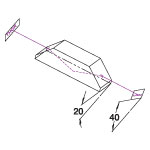 |
Dove prisms may invert, reverse, or rotate an image based on which face the light is incident on. Prism in a beam rotator orientation. |
| 180° | 180° | No | 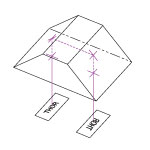 |
Prism acts as a non-reversing mirror. Same properties as a retroreflector or right angle (180° orientation) prism in an optical setup. |
||
| Wedge Prisms | N-BK7 | Models Available from 2° to 10° | No | No |  |
Beam steering applications. By rotating one wedged prism, light can be steered to trace the circle defined by 2 times the specified deviation angle. |
| No | No |  |
Variable beam steering applications. When both wedges are rotated, the beam can be moved anywhere within the circle defined by 4 times the specified deviation angle. |
|||
| Coupling Prisms | Rutile (TiO2) or GGG | Variablea | No | No | 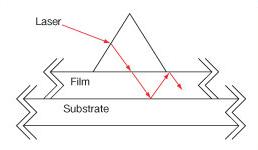 |
High index of refraction substrate used to couple light into films. Rutile used for nfilm > 1.8 GGG used for nfilm < 1.8 |
Dispersive Prisms
| Prism | Material | Deviation | Invert | Reverse or Rotate | Illustration | Applications |
|---|---|---|---|---|---|---|
| Equilateral Prisms | F2, N-F2, N-SF11, Calcium Fluoride, or Zinc Selenide |
Variablea | No | No | 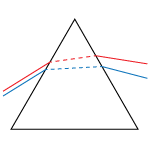 |
Dispersion prisms are a substitute for diffraction gratings. Use to separate white light into visible spectrum. |
| Dispersion Compensating Prism Pairs | Fused Silica, Calcium Fluoride, SF10, or N-SF14 | Variable Vertical Offset | No | No |  |
Compensate for pulse broadening effects in ultrafast laser systems. Can be used as an optical filter, for wavelength tuning, or dispersion compensation.
|
| Pellin Broca Prisms | N-BK7, UV Fused Silica, or Calcium Fluoride |
90° | 90° | No | 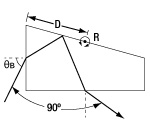 |
Ideal for wavelength separation of a beam of light, output at 90°. Used to separate harmonics of a laser or compensate for group velocity dispersion. |
Beam Manipulating Prisms
| Prism | Material | Deviation | Invert | Reverse or Rotate | Illustration | Applications |
|---|---|---|---|---|---|---|
| Anamorphic Prism Pairs | N-KZFS8 or N-SF11 |
Variable Vertical Offset | No | No | 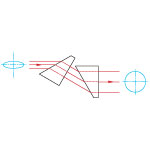 |
Variable magnification along one axis. Collimating elliptical beams (e.g., laser diodes) Converts an elliptical beam into a circular beam by magnifying or contracting the input beam in one axis. |
| Axicons (UVFS, ZnSe) | UV Fused Silica or Zinc Selenide |
Variablea | No | No |
Creates a conical, non-diverging beam with a Bessel intensity profile from a collimated source. |
Polarization Altering Prisms
| Prism | Material | Deviation | Invert | Reverse or Rotate | Illustration | Applications |
|---|---|---|---|---|---|---|
| Glan-Taylor, Glan-Laser, and α-BBO Glan-Laser Polarizers | Glan-Taylor: Calcite Glan-Laser: α-BBO or Calcite |
p-pol. - 0° s-pol. - 112°a |
No | No |  |
Double prism configuration and birefringent calcite produce extremely pure linearly polarized light. Total Internal Reflection of s-pol. at the gap between the prism while p-pol. is transmitted. |
| Rutile Polarizers | Rutile (TiO2) | s-pol. - 0° p-pol. absorbed by housing |
No | No | 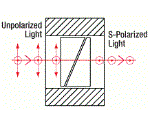 |
Double prism configuration and birefringent rutile (TiO2) produce extremely pure linearly polarized light. Total Internal Reflection of p-pol. at the gap between the prisms while s-pol. is transmitted.
|
| Double Glan-Taylor Polarizers | Calcite | p-pol. - 0° s-pol. absorbed by housing |
No | No | 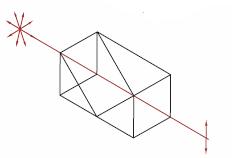 |
Triple prism configuration and birefringent calcite produce maximum polarized field over a large half angle. Total Internal Reflection of s-pol. at the gap between the prism while p-pol. is transmitted. |
| Glan Thompson Polarizers | Calcite | p-pol. - 0° s-pol. absorbed by housing |
No | No | 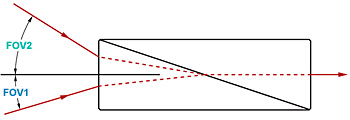 |
Double prism configuration and birefringent calcite produce a polarizer with the widest field of view while maintaining a high extinction ratio. Total Internal Reflection of s-pol. at the gap between the prism while p-pol. is transmitted. |
| Wollaston Prisms and Wollaston Polarizers |
Quartz, Magnesium Fluoride, α-BBO, Calcite, Yttrium Orthovanadate | Symmetric p-pol. and s-pol. deviation angle |
No | No | 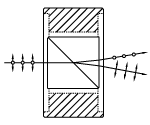 |
Double prism configuration and birefringent calcite produce the widest deviation angle of beam displacing polarizers. s-pol. and p-pol. deviate symmetrically from the prism. Wollaston prisms are used in spectrometers and polarization analyzers. |
| Rochon Prisms | Magnesium Fluoride or Yttrium Orthovanadate |
Ordinary Ray: 0° Extraordinary Ray: deviation angle |
No | No | 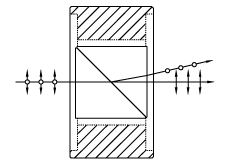 |
Double prism configuration and birefringent MgF2 or YVO4 produce a small deviation angle with a high extinction ratio. Extraordinary ray deviates from the input beam's optical axis, while ordinary ray does not deviate. |
| Beam Displacing Prisms | Calcite | 2.7 or 4.0 mm Beam Displacement | No | No | 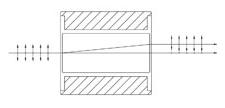 |
Single prism configuration and birefringent calcite separate an input beam into two orthogonally polarized output beams. s-pol. and p-pol. are displaced by 2.7 or 4.0 mm. Beam displacing prisms can be used as polarizing beamsplitters where 90o separation is not possible. |
| Fresnel Rhomb Retarders | N-BK7 | Linear to circular polarization Vertical Offset |
No | No | 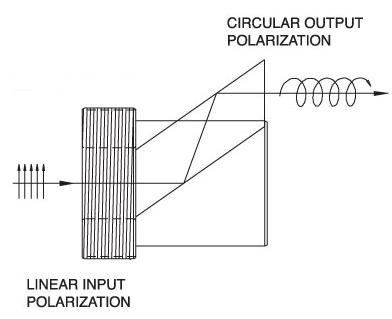 |
λ/4 Fresnel Rhomb Retarder turns a linear input into circularly polarized output. Uniform λ/4 retardance over a wider wavelength range compared to birefringent wave plates. |
| Rotates linearly polarized light 90° | No | No | 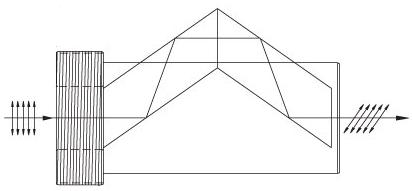 |
λ/2 Fresnel Rhomb Retarder rotates linearly polarized light 90°. Uniform λ/2 retardance over a wider wavelength range compared to birefringent wave plates. |
Beamsplitter Prisms
| Prism | Material | Deviation | Invert | Reverse or Rotate | Illustration | Applications |
|---|---|---|---|---|---|---|
| Beamsplitter Cubes | N-BK7 | 50:50 splitting ratio, 0° and 90° s- and p- pol. within 10% of each other |
No | No |  |
Double prism configuration and dielectric coating provide 50:50 beamsplitting nearly independent of polarization. Non-polarizing beamsplitter over the specified wavelength range. |
| Polarizing Beamsplitter Cubes | N-BK7, UV Fused Silica, or N-SF1 | p-pol. - 0° s-pol. - 90° |
No | No | 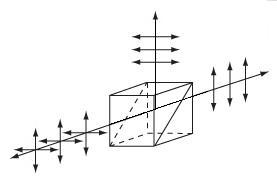 |
Double prism configuration and dielectric coating transmit p-pol. light and reflect s-pol. light. For highest polarization use the transmitted beam. |
 Products Home
Products Home









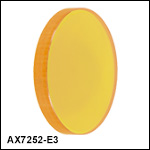
 Zoom
Zoom ZeSe Axicons, Unmounted
ZeSe Axicons, Unmounted